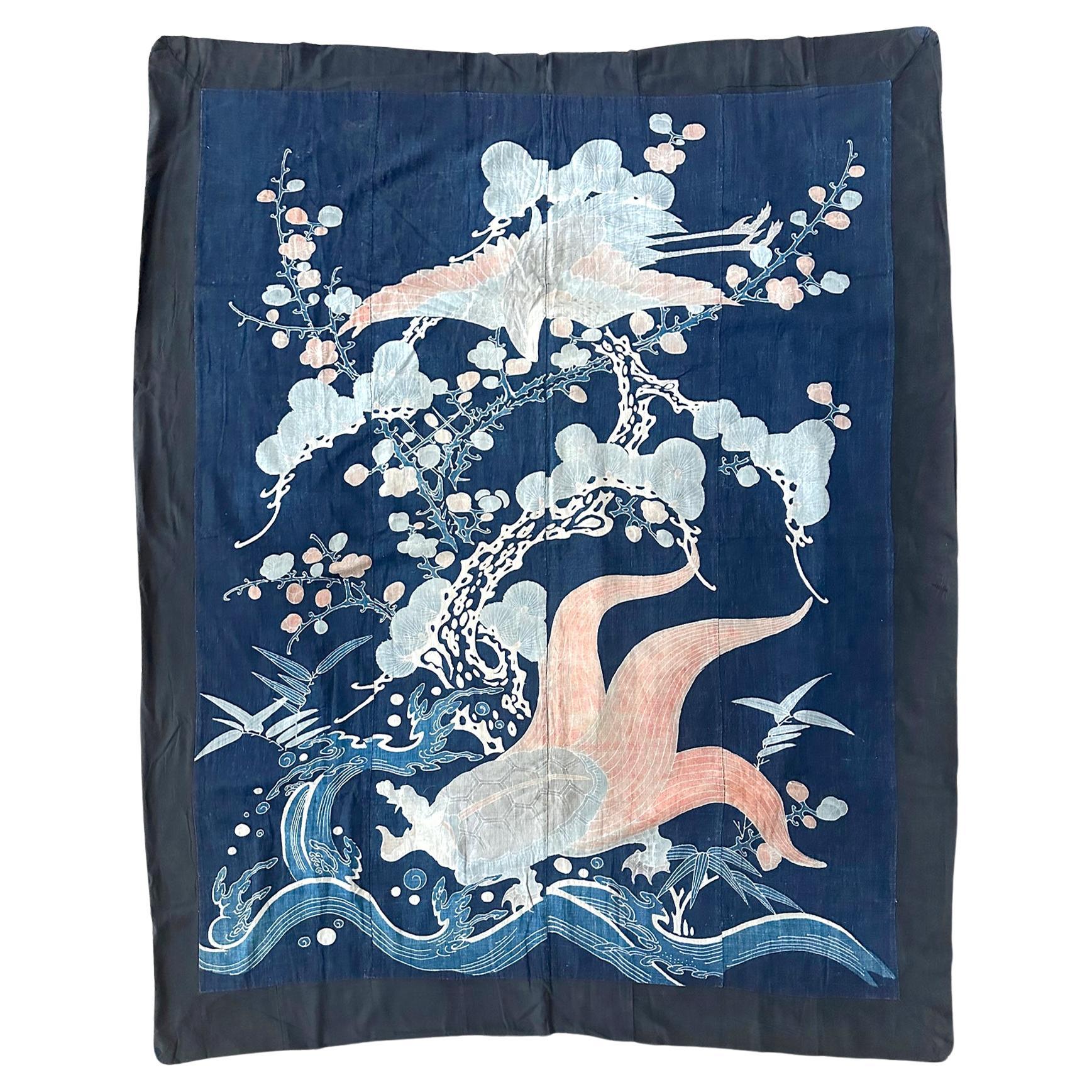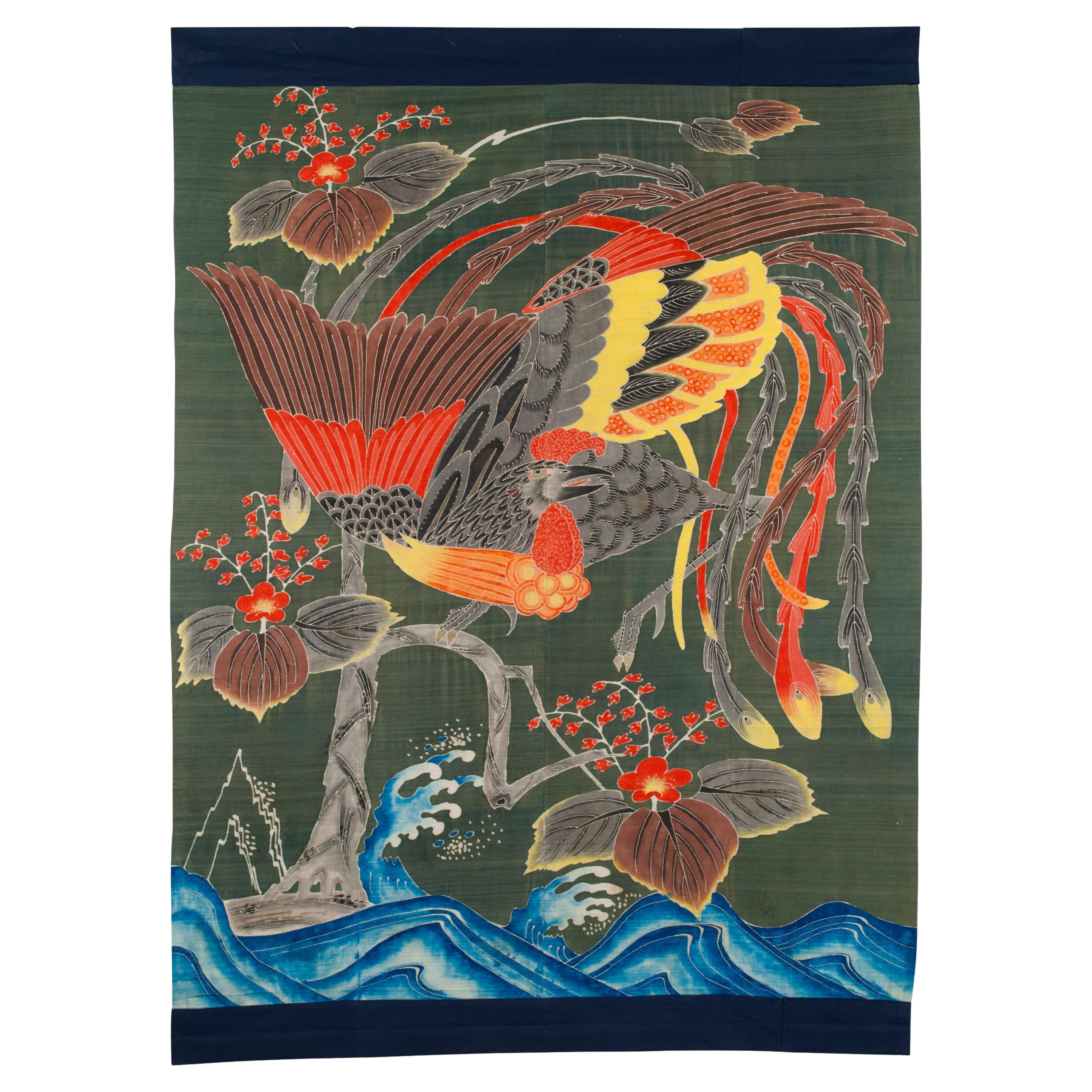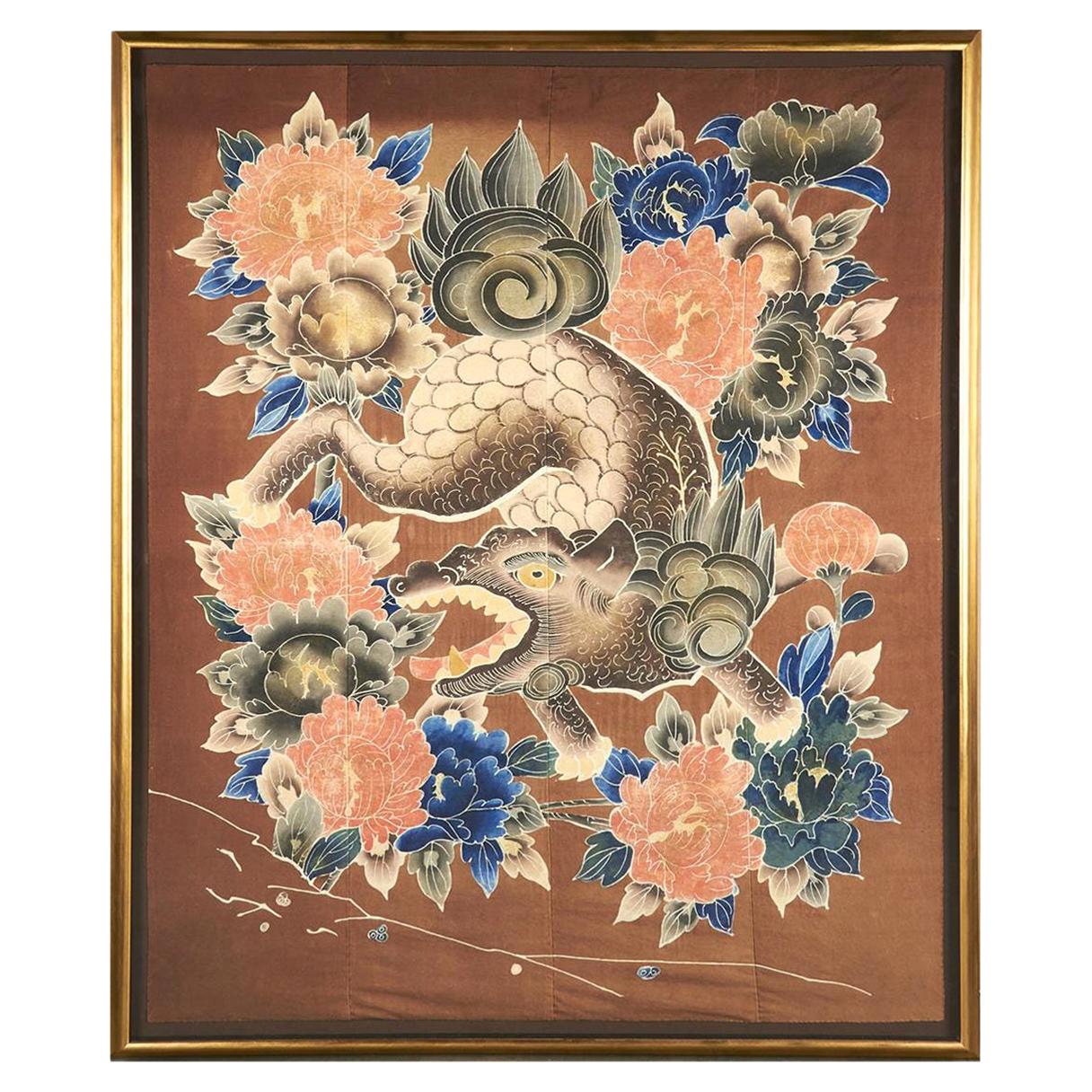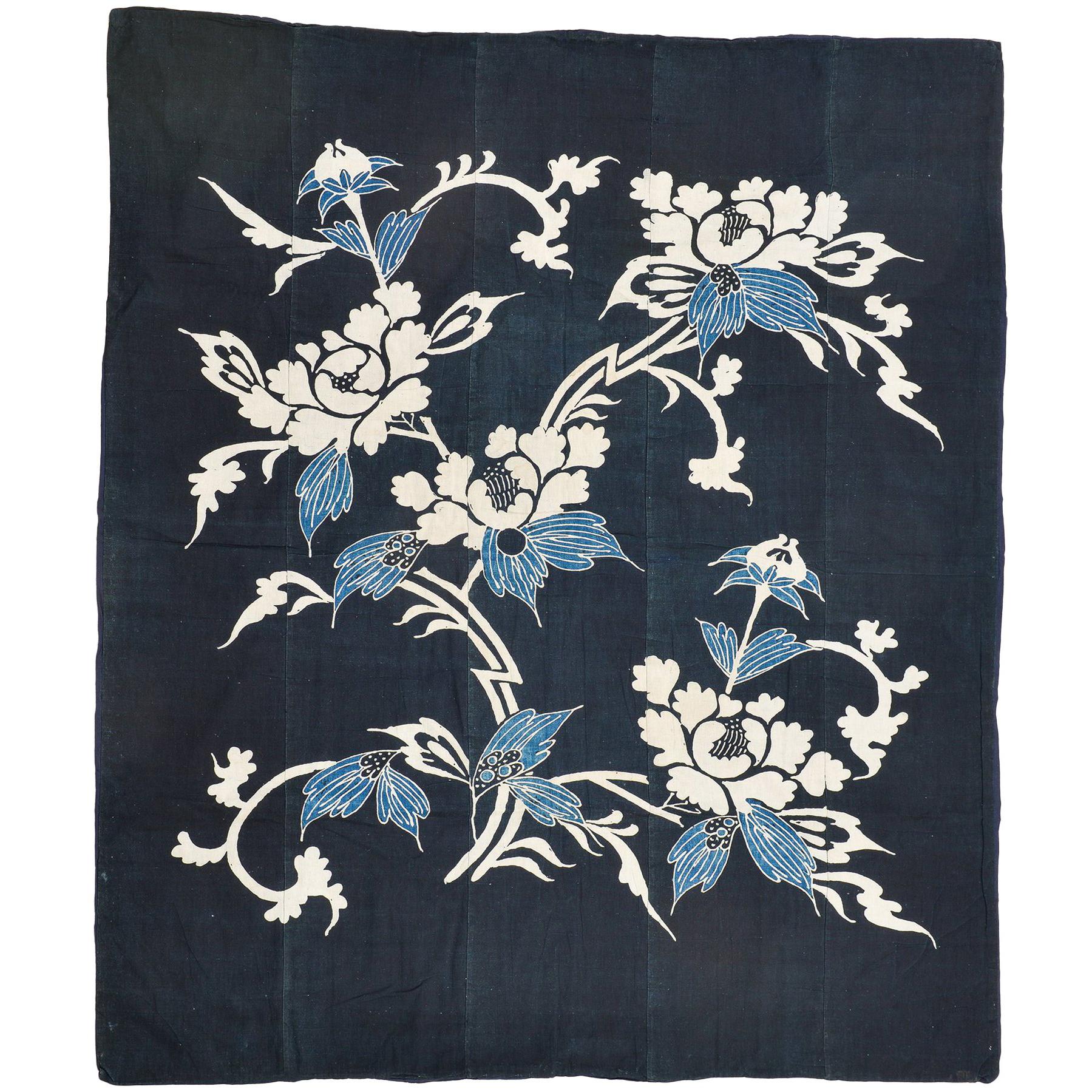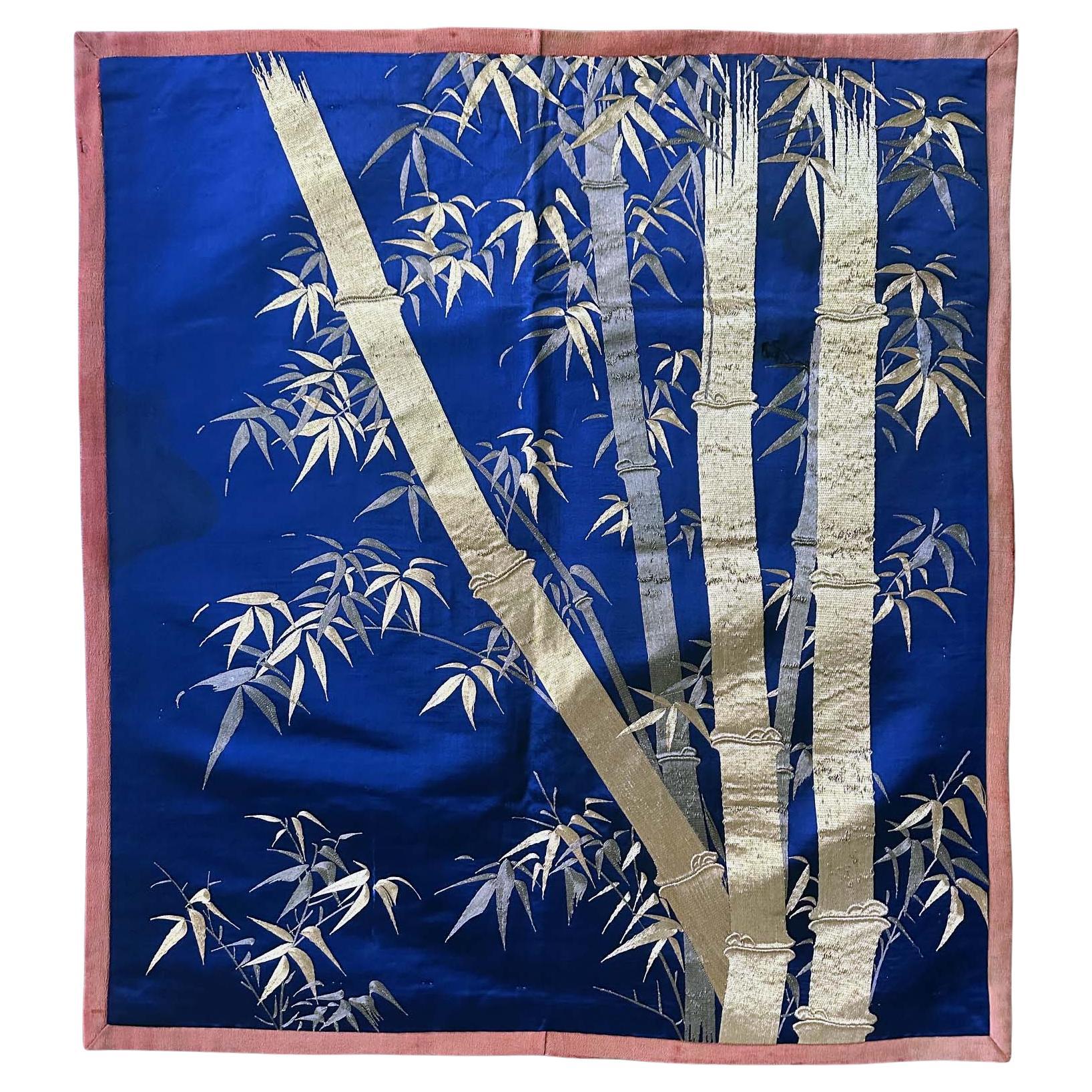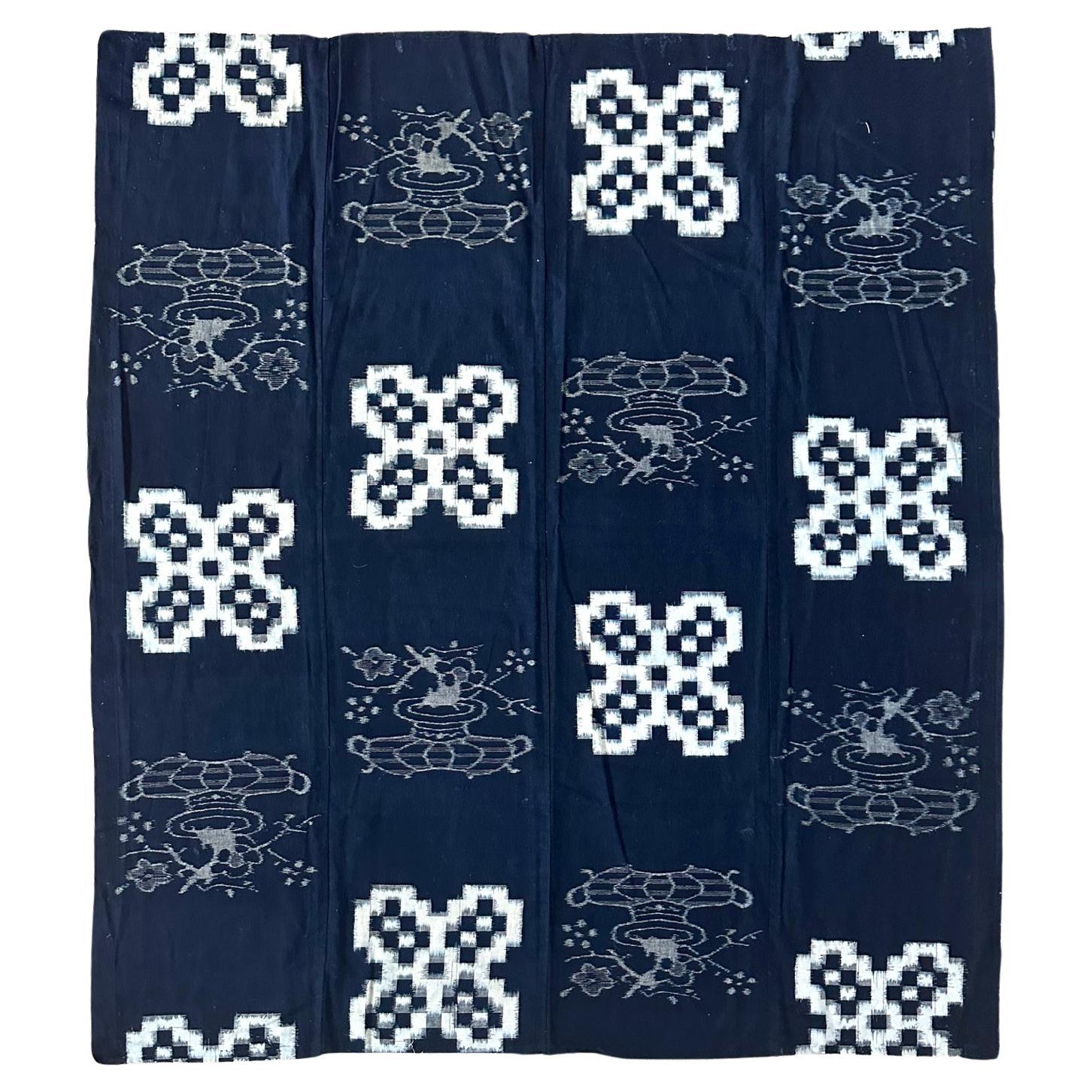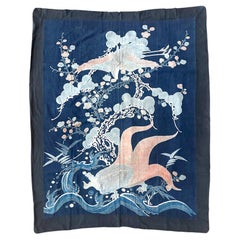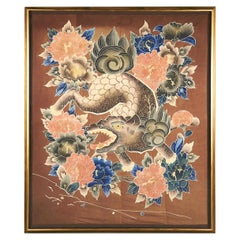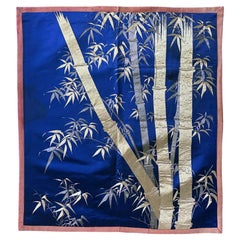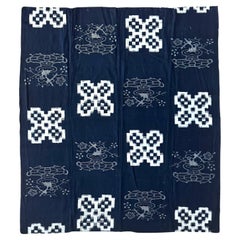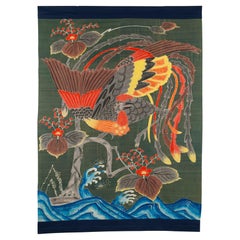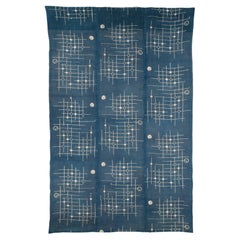Items Similar to Large Japanese Textile Futon Cover with Resist Yuzen Dye
Want more images or videos?
Request additional images or videos from the seller
1 of 13
Large Japanese Textile Futon Cover with Resist Yuzen Dye
$3,850
£2,922.85
€3,343.12
CA$5,379.01
A$5,982.63
CHF 3,123.94
MX$72,802.26
NOK 39,897.53
SEK 37,416.85
DKK 24,951
Shipping
Retrieving quote...The 1stDibs Promise:
Authenticity Guarantee,
Money-Back Guarantee,
24-Hour Cancellation
About the Item
A large unframed Japanese textile art circa late early 20th century toward the end of the Meiji period. Seamed together from four vertical sections of cotton in deep indigo color, this large piece was made as a Futonji (futon cover) or Yutan (covering cloth) for domestic use. It showcases a beautiful pictorial design with two cranes, one standing, one flying on a background of pine tree, bamboo and plum blossom. On the lower right corner there is a longevity tortoise called Minogame in Japanese. The imagery is full of symbolism. The pine, bamboo and plum trees are collectively known as "three friends in winter". Their cold-resilient character represents inner strength. While minogame is the symbols of longevity, the red-crowned crane, beloved in Japan, project fidelity in marriage, good luck, long life and love. On four corners, there are prominent Choji mons (clover design), likely indicating the family which the Futonji belonged to.
Achieved using Tsutsugaki method of Yuzen dye, a technique of free hand resist dying using rice paste, which involves many painstaking steps, and all done by hands in the workshop, this panel retains vibrant colors and remains in remarkable condition. The back is fresh as it was likely taken off the futon cover a long ago and used as a wall hanging.
Reference: for several examples of Futonji and Yutan, see Textile of Japan: The Thomas Murray Collection at the Minneapolis Institute of Art" (Prestell) page 224-250.
- Dimensions:Height: 64 in (162.56 cm)Width: 48 in (121.92 cm)Depth: 0.2 in (5.08 mm)
- Style:Meiji (Of the Period)
- Materials and Techniques:Cotton,Dyed
- Place of Origin:
- Period:
- Date of Manufacture:Early 20th Century
- Condition:Wear consistent with age and use. Textile in overall good condition with vivid color and minor expected wear, spots of discoloration barely noticeable. Edges folded back and clean. No obvious stain or odor. Folding wrinkles.
- Seller Location:Atlanta, GA
- Reference Number:1stDibs: LU945038699632
About the Seller
4.9
Platinum Seller
Premium sellers with a 4.7+ rating and 24-hour response times
Established in 2006
1stDibs seller since 2010
564 sales on 1stDibs
Typical response time: <1 hour
- ShippingRetrieving quote...Shipping from: Atlanta, GA
- Return Policy
Authenticity Guarantee
In the unlikely event there’s an issue with an item’s authenticity, contact us within 1 year for a full refund. DetailsMoney-Back Guarantee
If your item is not as described, is damaged in transit, or does not arrive, contact us within 7 days for a full refund. Details24-Hour Cancellation
You have a 24-hour grace period in which to reconsider your purchase, with no questions asked.Vetted Professional Sellers
Our world-class sellers must adhere to strict standards for service and quality, maintaining the integrity of our listings.Price-Match Guarantee
If you find that a seller listed the same item for a lower price elsewhere, we’ll match it.Trusted Global Delivery
Our best-in-class carrier network provides specialized shipping options worldwide, including custom delivery.More From This Seller
View AllAntique Large Japanese Futon Cover with Resist Yuzen Dye
Located in Atlanta, GA
A large unframed Japanese Futonji textile art circa late 19th century toward the end of the Meiji period. Seamed together from four vertical sections of cotton in deep indigo color, ...
Category
Antique 1890s Japanese Meiji Textiles
Materials
Cotton
Framed Japanese Futon Cover Textile Art with Resist Yuzen Dye
Located in Atlanta, GA
A large piece of framed Japanese textile circa late 19th to early 20th century, end of Meiji period. Seamed together from four vertical sectio...
Category
Early 20th Century Japanese Meiji Textiles
Materials
Cotton, Wood
Japanese Embroidery Silk Bamboo Fukusa Meiji Period
Located in Atlanta, GA
A Japanese silk embroidery Fukusa panel circa 1890-1910s toward the end of Meiji Period. On the deep blue satin background, the artist showcases a clump of bamboos in a realistic sty...
Category
Early 20th Century Japanese Meiji Textiles
Materials
Silk
Japanese Textile Panel Double Ikat Kasuri Futon Cover
Located in Atlanta, GA
A Japanese woven cotton textile panel with white pattern on indigo background circa 1900-20s (end of Meiji to Tasho period). The panel was joined by four vertical stripes and was tra...
Category
Early 20th Century Japanese Meiji Textiles
Materials
Cotton
Japanese Antique Fusuka Textile Art Meiji Period
Located in Atlanta, GA
A Japanese silk Fukusa panel circa late 19th-early 20th century of Meiji Period. The front was beautifully decorated with Yuzen-zome, a labor intensive resist-dye technique invested by an artist monk Miyazaki Yuzensai (1654 -1736) of Edo period. The auspicious composition features a group of red-crown cranes, the symbol of longevity. Three of them perch on the rock by the ocean (East Sea) an two of them are in flight. Additionally, two egrets frolic in the wave. Yuzen dying was used extensively to showcase the amazing details such as the waves and the gradual coloring effect. Embroidery was used sparsely to highlight areas such as the legs of the crane to render it more dimensional details.
The piece has a red silk backing and still retains four blue tassels on corners as well as decorative stitches along the edges.
Fukusa is a traditional Japanese textile...
Category
Early 20th Century Japanese Japonisme Textiles
Materials
Brocade, Silk
Japanese Antique Fukusa Textile Art Meiji Period
Located in Atlanta, GA
A Japanese silk Fukusa panel circa late 19th-early 20th century of Meiji Period. The front was beautifully decorated with Yuzen-zome, a labor intensive resist-dye technique invested by an artist monk Miyazaki Yuzensai (1654 -1736) of Edo period. The front cover likely depicts a scene from the Tale of Genji, showing a nobleman and his servant pays a visit to a lady in a fenced thatch-roof house under a high peak. The details of blossom trees and pines, as well as the characters, and scenery with a gradual color are astounding. It is telling that the Yuzen dying was used such an mastery.
The piece has a red silk backing and still retains two red tassels on the lower corners as well as decorative stitches along the edges. There is a patched design on the back likely a Mon symbol (family crest).
Fukusa is a traditional Japanese textile...
Category
Early 20th Century Japanese Japonisme Textiles
Materials
Silk
You May Also Like
Rare Antique Formal Japanese Silk Tsutsugaki Futon Cover
Located in Point Richmond, CA
Rare Antique Formal Japanese Silk Tsutsugaki Futon Cover
An exceptional example of tsutsugaki from the late Meiji period. The abstract rendering of the auspicious phoenix and paulo...
Category
Antique Late 19th Century Japanese Meiji Tribal Art
Materials
Cotton, Silk
Japanese Indigo Antique Boro Futon Cover or Wall Panel
Located in Alessandria, Piemonte
Rare perfect antique collection Japanese Indigo Boro Futon cover : also to use.
The rare antique boros are now valued as pieces of art, therefore they are...
Category
Mid-20th Century Japanese Japonisme Textiles
Materials
Cotton
$2,492 Sale Price
35% Off
Rare Antique Japanese Oversized Sleeping Kimono (Yogi)
Located in Point Richmond, CA
Rare Antique Japanese Oversized Sleeping Kimono (Yogi)
This is the outer shell of a type of shaped sleeping kimono known as a yogi. Yogi were in more common use during the Edo and M...
Category
Antique Late 19th Century Japanese Meiji Tribal Art
Materials
Cotton, Linen
Early 20th Century Japanese Linen Go-Board Pattern Futon Cover
Located in Point Richmond, CA
Early 20th Century Japanese linen go-board pattern futon cover
A unique example of a game-themed textile, this 3-panel futon cover is woven of very fine...
Category
Early 20th Century Japanese Meiji Textiles
Materials
Hemp
Vintage Japanese Obi Textile, Mid 20th C
Located in Istanbul, TR
An obi in very good condition that can be utilized as a table runner, wall hanging.
Category
Mid-20th Century Japanese Pillows and Throws
Materials
Silk
Japanese Vintage Fabric, Wabi Sabi, 1910s
Located in Tokyo, Tokyo
This unique and elegant textile with a phoenix pattern, known as Nagasaki Sarasa, was made in Nagasaki Prefecture (Kyushu) during the Taisho era.
The fabric was likely intended fo...
Category
Vintage 1910s Japanese Textiles
Materials
Cotton
More Ways To Browse
Large Textile Wall Art
Dior Asia
Two Cranes
Large Japanese Wall Art
Thomas Crown
Meiji Cranes
Flying Cranes
Antique Japanese Wall Panels
Japanese Indigo Textile
Tortoise Bamboo
Tree Of Life Wall Hanging
Bamboo Wall Panel
Asian Crane Panel Art
Antique Japanese Indigo
Japanese Crane Panel
Crown Crane
Crowned Crane
Indigo Wall Hanging
